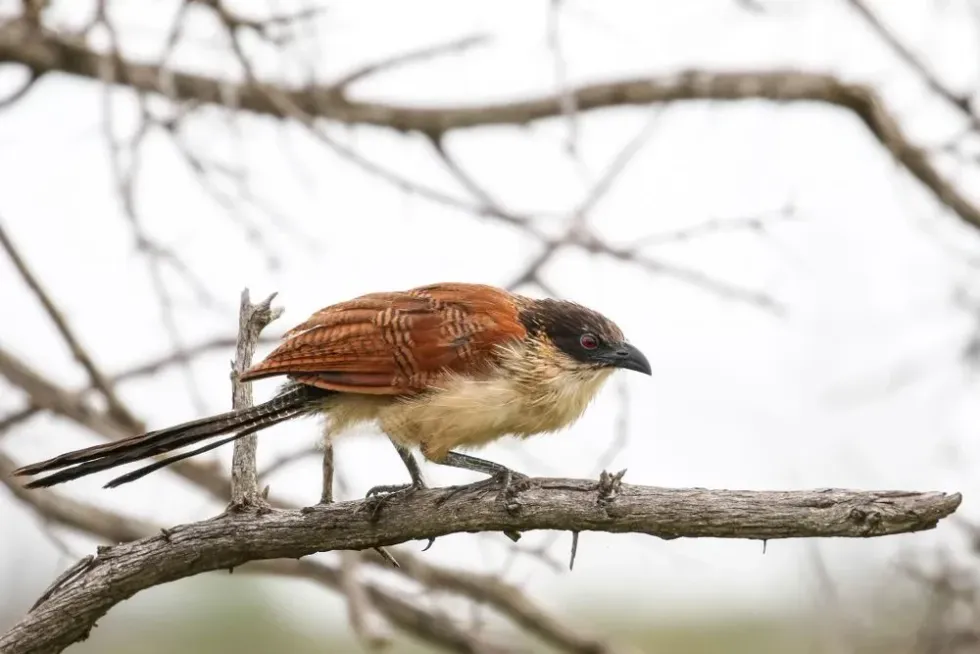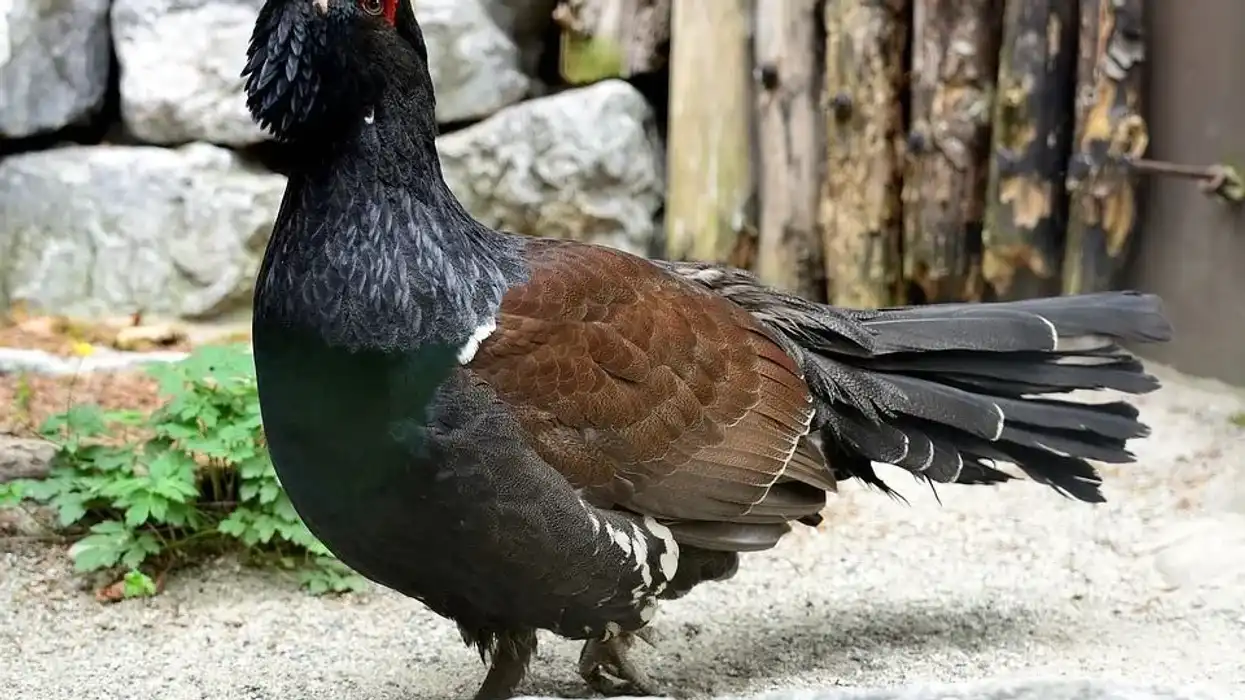The Burchell’s coucal (Centropus burchelli) is a species of the cuckoo family. The common names for this bird are gewone vleiloerie in the Afrikaans language and umGugwane in the Zulu language.
It is a subspecies of the white-browed coucal (Centropus superciliosus) and named after William John Burchell, a British naturalist. The distribution range of this bird extends South Africa to other regions in southern Africa though mostly found in South Africa itself. It is known as the ‘rainbird’ due to its sound which is heard before a rainfall.
It belongs to the Cuculidae family of animals. The description of the bird is incomplete without mentioning its most prominent feature, its black head, and tail. The bird loos for dense vegetation cover for building the nests in thorny trees close to the ground.
For more information about other bird species, check out Lilian's lovebird facts and brown-headed barbet facts.
Burchell's Coucal Interesting Facts
What type of animal is a Burchell's coucal?
The Burchell's coucal is a bird species belonging to the Cuculidae family. It is often considered a subspecies of the white-browed coucal (Centropus superciliosus)
What class of animal does a Burchell's coucal belong to?
Like all other bird species, the Burchell’s coucal also belongs to the Aves class of animals. It is a member of the cuckoo family.
How many Burchell's coucals are there in the world?
There is not much data available about the exact numbers of Burchell's coucals in the world. But since this bird is a species of Least Concern, according to the IUCN Red List, it is safe to assume that their distribution is ample in the world.
Where does a Burchell's coucal live?
The Burchell’s coucal (Centropus burchelli) builds its nest between thick shrubs and bushes. It prefers a dense vegetation cover with rank undergrowth.
The bird likes nesting in suitable coastal regions and borders between grassland and woodlands. People have spotted the Burchell’s coucal in sugar cane plantations as well. The habitat of this species occurs in areas that get a lot of rainfall annually.
What is a Burchell's coucal's habitat?
The Burchell’s coucal (Centropus burchelli) is almost endemic to southern Africa with a vast range of distribution extending from northern Namibia to southern Malawi. These birds are also found in southern and eastern South Africa while the range of its population is distributed through Mozambique, Zimbabwe, and Botswana.
The coastline along Cape Town is one of the favorable nesting sites of the Burchell’s Coucal.
Who do Burchell's coucals live with?
The Burchell's coucal (Centropus burchelli), as well as its subspecies the white-browed coucal (Centropus superciliosus), can be found in pairs or living a solitary life.
How long does a Burchell's coucal live?
It is regrettable that there is not much information available on the lifespan of the Burchell’s coucal, which makes it difficult to state the average lifespan of these birds. However, its subspecies, the white-browed coucal (Centropus supercilious), has been documented to live for almost four years. It is safe to assume that the Burchell’s coucal also lives as long.
How do they reproduce?
The breeding season of the Burchell’s coucal is between September and March with minor variations in various regions of southern Africa. The eggs are laid during this time in numbers of two to five with a gap of one or two days between each egg.
The nest is built by the male and consists of a deep cup-shaped structure made up of leaves and grass. This nest is placed about 19.69-393.70 in (50-1000 cm) above the ground in a bush, thorny tree, or large grass tuft.
The incubation period goes on for about 15-16 days and is majorly done by the male. The chicks hatch from the eggs soon after and their feet are developed quickly which makes them move about the nest.
The male takes care of the young feeding them. The young birds take some time to fly, and they leave the nest after about 21 days. The young chick depends on its parents for several weeks after it moves out.
What is their conservation status?
According to the data of the IUCN Red List of Threatened Species, the Burchell’s coucal (Centropus burchelli) is listed on the same page as the white-browed coucal (Centropus superciliosus), with both listed as a species of Least Concern with a stable population trend. These birds will not face extinction for now.
Burchell's Coucal Fun Facts
What do Burchell's coucals look like?

The Burchell’s coucal (Centropus burchelli) is a member of the cuckoo family with chestnut brown colored wings and back. The underparts are white in color while the most distinct feature that separates it from the subspecies white-browed coucal (Centropus superciliosus) is its black-colored head as opposed to the light brown head of the latter species.
Its feet, legs, and bill are also black. It also has a long black tail. The white throat is a special feature of this bird.
The eyes of these coucals are deep red in color giving it a striking look very different from other birds. The description of the bird tells you that it is a colorful species.
How cute are they?
Instead of calling the Burchell’s coucal cute, you might find it a bit scary due to its black head with red eyes. It is a dangerous predator too.
How do they communicate?
The Burchell’s coucal has a distinctive call that sounds like water being poured from a container. The bird is often named ‘rainbird’ as their call often signals impending rainfall.
The bird emits other sounds like the ‘dove’ call and the alarm hiss. During the breeding season, the cuckoo species becomes most vocal when a pair might call in duet or a number of birds might call in concert.
How big is a Burchell's coucal?
The Burchell’s coucal may grow up to a length of 14.17-16.54 in (36-42 cm). It is smaller than the channel-billed cuckoo that is about 22–27.5 in (56–70 cm ) long while being larger than the little yellow-billed cuckoo, whose length is 10.2-11.8 in (26-30 cm).
How fast can a Burchell's coucal fly?
Although the exact flight speed of the Burchell’s coucal is not known, when the birds fly, they fly very low to the ground and at a fast speed. The flying consists of short bursts of flapping of wings and then gliding afterward.
How much does a Burchell's coucal weigh?
The weight of the Burchell's coucal is approximately 6 oz (170g). This makes it heavier than the black-billed cuckoo.
What are the male and female names of the species?
There are no sex-specific names for male and female coucals.
What would you call a baby Burchell's coucal?
A baby Burchell's coucal is called a chick.
What do they eat?
The diet of a Burchell’s coucal consists mainly of insects, but it has only been known to feed on eggs and young birds. It is a voracious predator whose diet is made up of even small animals like mice, frogs, lizards, chameleons, and mole rats.
Occasionally they may feed on small snakes as well. Birds like sparrows, warblers, pigeons, and doves also add to the diet of these coucals.
Are they dangerous?
The Burchell's coucal is a predatory bird but mostly harmless for humans. Their habitat consists of dense vegetation and grass cover in the southern African region that is mostly uninhabited by human beings.
Would they make a good pet?
No, the Burchell's coucal is a wild bird species that are not at all suitable for life in captivity.
Did you know...
The bird is named after the British biologist William John Burchell.
In Afrikaans, Burchell’s coucal is called gewone vleiloerie.
What sound does a Burchell's coucal make?
The sound of the Burchell’s coucal is often termed as the ‘rainbird’s liquid note’ as the sound emitted by the bird is very similar to water pouring from a bottle. Other sounds consist of the ‘dove’ call as well as the alarming hiss sound.
Do Burchell's coucals migrate?
There is no record to show that these birds migrate from one dense vegetation cover to another.
Here at Kidadl, we have carefully created lots of interesting family-friendly animal facts for everyone to discover! Learn more about some other birds from our albatross facts and Franklin gull facts pages.
You can even occupy yourself at home by coloring in one of our free printable bird wearing clothes coloring pages.
Second image by Derek Keats.










